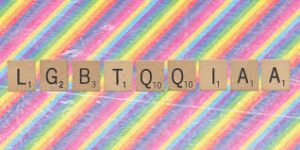P is for people and P is for Pride which gives everyone the chance to celebrate the rich diversity of their gender and sexual identities – and for others to fully acknowledge them, too.
Many know what LGBTQ means but significantly fewer would be able to easily to reel off what all of LGBTQQIAAP stands for. In practice, the most common acronym in use is LGBTQ+, with the ‘+’ added as an inclusive way to acknowledge the many different identities in the longer version. Even then, the 10 letter version may not be exhaustive in the different ways people define their gender and sexuality.
To start with the shorter one: L is for lesbian, a woman who is attracted to other women; G is for gay, a man attracted to men or, more broadly, a person who identifies as homosexual; B is for bisexual, a person who is attracted to both men and women; T is for transgender, a person who identifies with a different one that is on their birth certificate and Q is for queer, originally a hate word, but now reclaimed by people who want to avoid identifying themselves only by their sexual activity.
LGBTQQIAAP Explained

The longer version has a second Q, here for questioning about their own sexual or gender identity. I is for intersex, for those people whose bodies are not definitively male or female, perhaps because their genitals are not ‘standard’ or they don’t have the common XX or XY chromosomes. The first A relates to someone who feels no sexual attraction, as in asexual, while the other A is for ally – someone who may identify as straight but supports the full LGBTQQIAAP+ community. Finally, the P is for pansexual, a person who is fluid when it comes to identifying their own gender, sexual identity or who they may be attracted to.
Sex And Gender
Having covered what the letters stand for, let’s go back to basics and start with what is ‘sex’. Apart from the activity, it refers to a person’s status, usually assigned at birth on the basis of external anatomy and is typically categorized as male, female or intersex.
Gender, is somewhat distinct in being a social construct of norms, behaviors and roles that vary considerably between different societies and different times. Gender is often categorized as male, female or non-binary. Gender identity is a person’s own sense of the sex or gender they identify with, whether that is man, woman, neither or both. Then there is how a person presents their gender outwardly – that is, their gender expression – through behavior, clothing, voice or other perceived characteristics.
Another term now commonly used is cisgender or, simply, cis. This is used to describe a person who aligns their gender identity with the sex they were assigned at birth. Cisgender and transgender have their origins in Latin-derived prefixes of “cis” and “trans” — cis, meaning “on this side of” and trans, meaning “across from” or “on the other side of.”
Then there is non-binary, a term used by people who do not view their genders as fitting into the either/or categories of male or female. And gender expansive can be used by someone with even more flexible gender identity than is used by a typical gender binary.
Gender dysphoria refers to psychological distress that can result from an incongruence between one’s sex assigned at birth and one’s gender identity. Some but not all people who are trans may experience dysphoria, and those who do, may experience it at varying levels of intensity. It is still listed as a medical condition, which some dispute as wrongly pathologizing gender incongruence, though others argue it makes it easier for people to access their desired treatment.
Back to our first P – People don’t need to have had any sexual experience to know their sexual orientation. Nor do they need to be dating, in a relationship or partnering anyone for their sexual orientation to be confirmed. After all, it goes without saying that a bisexual woman with a man as a partner is still. bisexual.
Pronouns That Identify
Another P is for pronouns –how we identify ourselves apart from our name, and how someone refers to you in conversation and in writing. Using the correct pronouns, especially for trans and nonbinary youth, is an important way to let them know that you see them, you affirm them, and accept them.
How to get this right? Well, you can start by giving your own – either verbally “I am [your name] and I use her pronouns” or in your sign off of an email or letter: e.g. [your name] (she/her). It may feel a bit strange at the start, but it should just become another routine getting-to-know-you expression. And the practice of stating one’s pronouns at the bottom of an email or during introductions at a meeting also has the advantage of relieving any awkwardness for people whose first names are less common or are gender ambiguous.
If you are uncertain, “they” is already commonly used as a singular pronoun when we are talking about someone, and we don’t know who they are. Using they/them pronouns for someone you do know simply requires a minor shift to remove gendered language when talking about someone.
It’s perfectly normal not to know the right words to use at first. We’re only human. If you get it wrong, simply apologize and move on. The important thing is to just be interested in wanting to make yourself better and more sensitive to the rich diversity of others.
So love being who you are and love who you want. Happy Pride!


